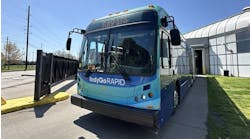Customers boarded Metro Transit buses and trains more than 81 million times in 2012 — an increase of 165,044 rides (0.2 percent) over 2011.
Ridership on the Hiawatha light-rail line was the highest in the line’s history at 10.5 million.
“For only the second time in a generation, Metro Transit ridership has exceeded 81 million,” said General Manager Brian Lamb. “This represents the third straight year of ridership growth.”
This also marks the sixth consecutive year in which ridership has topped 76 million – a mark not previously achieved since 1983. Customers boarded Metro Transit buses and trains 81,053,506 times in 2012, which helped to push the agency’s 40-year lifetime ridership past the 3 billion mark in November.
Bus Service
Bus ridership was up 0.1 percent to 69,854,994. Urban local routes – the heart of Metro Transit’s all-day service – remained essentially flat at 59 million rides. Ridership on freeway-oriented express routes was up 0.9 percent, or 88,000 rides, to 9.5 million while rides on suburban crosstown routes grew 6.4 percent, or nearly 100,000 rides, to 1.7 million.
“In 2011, Metro Transit bus ridership grew more than four percent – significantly outpacing transit systems around the county,” said Lamb. “Those new customers continued to choose Metro Transit throughout 2012.”
Hiawatha Light Rail
At 10,498,236, ridership on the Hiawatha Light-Rail line is the highest recorded since the line’s 2004 opening.
“We’re particularly grateful to our customers and proud to achieve this benchmark in a year that included the longest service disruption in Hiawatha’s eight-year history,” said Lamb.
In February, rail operations on a portion of the line were interrupted for a work week as crews stabilized a compromised pedestrian bridge that passes over Highway 55 and the Hiawatha Line near Lake Street / Midtown Station.
Average weekday ridership on the Hiawatha Line exceeds projections for the year 2020 by nearly 30 percent.
NORTHSTAR COMMUTER RAIL
Overall annual ridership on Northstar declined 0.45 percent due to a 13 percent reduction in the number of riders travelling to special events downtown. These reductions were offset partially by increases in the core market of weekday commuters. For the year, weekday commuter ridership was up four percent. A fare reduction implemented in August yielded progressively larger monthly increases in weekday riders over mid-year figures – from a six percent increase in September to nearly a 20 percent increase in December. Weekday ridership was also boosted by higher-than-projected rides from Ramsey Station which opened in November.
“We surveyed potential customers early in the year and they told us they’d use Northstar more often if fares were modestly reduced,” said Lamb. “The price adjustment has drawn new customers who continue to choose Northstar day after day.” The line proved its reliability again in 2012 with near-perfect on-time performance of 97 percent.


